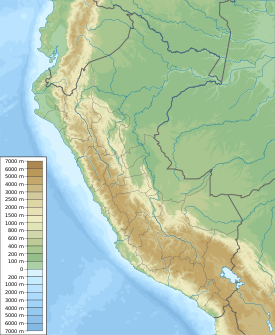Лобос-де-Тьєрра
| Лобос-де-Тьєрра | |
|---|---|
 | |
| Географія | |
| 6°25′40″ пд. ш. 80°51′29″ зх. д. / 6.42777778002777822° пд. ш. 80.85805556002777905° зх. д.Координати: 6°25′40″ пд. ш. 80°51′29″ зх. д. / 6.42777778002777822° пд. ш. 80.85805556002777905° зх. д. | |
| Природоохоронна територія | Guano Islands, Islets, and Capes National Reserve Systemd |
| Акваторія | Тихий океан |
| Площа | 16 км² |
| Довжина | 10 км |
| Ширина | 3 км |
| Країна | |
|
| |
| Населення |
0 осіб |
 | |
|
| |
Лобос-де-Тьєрра (ісп. Lobos de Tierra) — перуанський острів, розташований за 19 км від материка поблизу півострова Ільєскас. Належить до регіону Ламбаєке. Займає площу 16 км 2. Максимальна довжина — 10 км, а ширина — 3 км.
У 1863 році було оцінено, що на острові були запаси гуано майже 7 мільйонів тонн[1]. Запаси потім експлуатувалися без жодного контролю і сьогодні це багатство майже зникло, а гуано, що залишилося, не має такої якості, як раніше.
Клімат цього острова дуже теплий, і тут розмножуються мартини домініканські,[2] олуші (блакитноногі, насканські та перуанські),[3][4] і баклани перуанські.[3] На узбережжі є численні леговища отаріїд. У морі ноді можна побачити синіх китів.[5]
Навколо острова є кілька дрібних острівців, таких як Ель-Леон і Альбатрос.
- ↑ Cushman, Gregory T. (2013). Guano and the Opening of the Pacific World: A Global Ecological History. Cambridge University Press. с. 59. ISBN 9781107004139.
An 1863 survey of the islands north of Lima identified 6.8 million metric tons of phosphatic guano on Isla Lobos de Tierra alone. All of those proved to be gross overestimates.
- ↑ Hince, Bernadette (2000). The Antarctic Dictionary: A Complete Guide to Antarctic English. Csiro Publishing. с. 199. ISBN 9780643102323.
The subantarctic Dominican or Kelp Gull (Larus dominicanus) is an even more remarkable invader, for it finds centres of maximum abundance, as a nesting bird, at localities so utterly unlike as the Strait of Magellan and Lobos de Tierra Island.
- ↑ а б Schulenberg, Thomas S.; Stotz, Douglas F.; Lane, Daniel F.; O'Neill, John P.; Parker, Theodore A. III (2010). Birds of Peru. Princeton Field Guides (вид. Revised and updated). Princeton University Press. с. 68, 70, 72. ISBN 9781400834495.
- ↑ Glynn, P. W., ред. (1990). Global Ecological Consequences of the 1982–83 El Niño-Southern Oscillation. Elsevier. с. 382—383. ISBN 9780080870908.
The Blue-footed Booby has a relatively wide breeding range -- from the Gulf of California, the Gulf of Panama (population ca 100 pairs, pers. obs.), the Galápagos, and southward to its overlap with the Peruvian Booby on Isla Lobos de Tierra, Peru.
- ↑ Marine Ornithology — Volumes 33-34 — Page 81 2005 — Peruvian Boobies on Lobos de Tierra are currently scarce, but their population in the middle of the last century probably exceeded 400000 individuals (Nelson I978).
